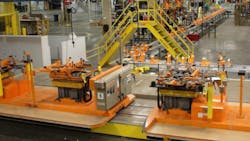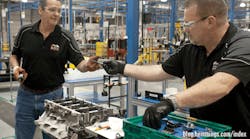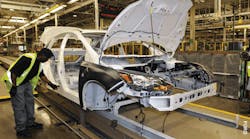When you’re touring a plant that makes huge Automated Guided Vehicles (AGVs) for automotive, aerospace and even nuclear power plants, you’re about as far away from an off-the-shelf retail mindset as you can get. Yet in talking to the folks at FORI Automation, which owns the Detroit-area plant they toured me through recently, one question I asked about their space utilization elicited a response I would have expected from a retailer. Our host couched his response in terms of “profit per square foot.”
That’s a calculation stores typically use to determine how much they’re making from every square foot of sales space. But when you realize that FORI’s plant floor changes about as often as displays move in and out of grocery stores, it makes sense to use this metric for building machines.
Being a proponent of lean manufacturing in the production of assembly-line support systems, FORI faces a challenge considering their set square footage under-roof combined with their constantly changing project load—and the need to track products associated with those projects.
“We have a master scheduler and system in place where we get down to the unit level,” says Mike Beck, vice president of global operations. “Every two months the scenery is different. Floor space drives that schedule as much as anything else. We run white board meetings on a weekly basis for each job. We project $90 million in job turnover this year in this location.”
That’s the metric that caught my attention. But it makes sense when you consider the volume of projects going through their limited amount of space—which was just expanded by another 15,000 sq. ft. with a new aerospace/AGV factory. They want every square foot to count. It’s also called “dollar density.” They have to be judicious about the value of the projects—and clients—they take on. A big module assembly line that requires 25,000 sq. ft. but only produces $10 million in revenue is harder to justify than filling that space with wheel alignment machines that only take up 25 x 40 sq. ft. each and generate $1 million apiece.
But with all the changes and moves that accompany new business, keeping aisles clean amidst all those added projects is both a challenge and a priority—especially for a lean organization. Considering Fori’s Shelby Township, Mich., plant is one of seven worldwide locations, housekeeping becomes a global task—as does production. Fori prides itself on being vertically integrated, meaning it can distribute work to where there’s available capacity. That comes in handy when a customer like Ford does a global launch of one of its products. When Ford launched a new product platform recently, Fori’s production was able to support it.
“We have a standard product called chassis marriage,” Beck explained. “Ford standardized on it and we design and build the same system for them around the world.”
That saves on shipping multiple systems from one location but there are also cases where one project can flow through multiple global locations to make best use of local talent and currencies.
“We can split a purchase order,” Beck added. “Fori Germany sold a job to a German client in India that wanted German engineering and project management, but they also wanted low cost manufacturing. We weren’t ready to go to China for assembly and integration so we used Fori Korea. We also saved the customer millions of dollars by splitting the purchase orders. For example, in an effort to remove the heavy import taxes from the contract, we split the contract and sent a PO for the installation and start-up support in Rupees to Fori India. Had we not done this our customer would have paid an additional 35% on this portion of the contract. In addition to receiving the PO in Indian Rupees, we also received POs in Fori USA and Fori Germany in U.S. Dollars and Euros respectively. To maintain low cost, we built some of the components in China, shipped them to Korea, integrated it there, then shipped it to India where it was installed. We used five Fori companies to deliver that line.”
That kind of partnership is mirrored in Fori’s relationship with Siemens, which supplies the controls in many of these projects. It’s a mutually beneficial relationship, in that Fori brings Siemens into more automotive projects than they’ve been used to and Siemens has been instrumental in opening the door to the aerospace industry for Fori.
“Siemens was instrumental in supporting Fori in the development and growth of our aerospace market and that’s through AGVs, which was a catalyst for us to break into new markets,” explained Paul Meloche, Fori’s vice president of sales. “Lockheed Martin was the project where Siemens brought us to the table.”
Today both companies have plenty of work, but like many of their industrial customers, they’re struggling to find the engineering talent to help them keep up with it.
“I have the easy job,” Meloche said. “It’s finding the mechanical and controls engineers and the people to support the designs. We’re all fishing in the same pond here in Detroit.”
“We’re trying every avenue we can think of,” Beck added. “We’ve used recruiters and gone to trade shows. You build your business with key personnel. In China, India and Brazil the challenge is retaining talent. Once they learn new skills you have to keep pace with pay. Those are markets where inflation is up to 10%, so your increases have to keep pace.”
Fori is part of a consortium of companies promoting education and they’re also educating the superintendents of their local schools that the jobs these companies offer have a future, pay well and that a four-year college degree is not for everyone. They need to aim that message at parents, too.
“We have opportunities on the shop floor and in engineering for college students in various phases,” Beck concluded. “Eventually they could come to work for us. We make a learning environment for them and help them with their college tuition.”
Fori obviously recognizes the dollar density in that deal—for itself and for all those parents.






